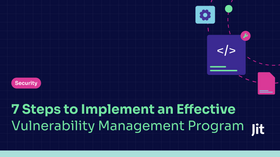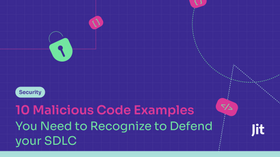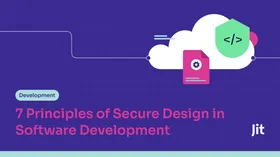Integrating SAST Into Your CI/CD Pipeline: A Step-by-Step Guide
Static application security testing (SAST) analyzes source code, bytecode, or binaries without executing the application, identifying vulnerabilities like SQL. Integrating it into your CI/CD pipelines means selecting the right tool, defining security policies and rules, automating feedback loops and triage, and fostering a culture of continuous improvement.
Published June 26, 2025

Did you know that the cost of fixing a bug found during implementation can be up to 100 times more expensive if discovered after product release? The importance of early vulnerability detection cannot be overstated, especially in today's fast-paced software development landscape where speed and security are no longer mutually exclusive.
As Continuous Integration/Continuous Delivery (CI/CD) pipelines become the backbone of modern development, ensuring the integrity of your code from the earliest stages is paramount. This is where static application security testing (SAST) shines. Integrating SAST directly into your CI/CD pipeline allows you to "shift left" on security, identifying vulnerabilities before they become costly problems downstream.
» Discover how Jit SAST can help you secure your code
The Importance of Static Application Security Testing (SAST)
Static application security testing (SAST) analyzes source code, bytecode, or binaries without executing the application, identifying vulnerabilities like SQL injection, XSS, or insecure API usage early in development.
Since it reviews the code itself, SAST helps developers fix issues before malicious code reaches production, making it a key tool in shift-left security practices. Integrating SAST to secure CI/CD pipelines yields the following benefits to both development teams and overall product security:
- Early detection of vulnerabilities: SAST identifies security flaws during coding or build stages—before the app is deployed. This "shift-left" approach catches issues like hardcoded secrets, SQL injection risks, or insecure APIs early, when fixes are easier and cheaper. It reduces the likelihood of security bugs making it into production, mitigating risks of exploitation and costly patch cycles later.
- Continuous, automated security checks: Embedding SAST into CI/CD ensures every commit or pull request triggers automated scans and continuous security monitoring. This provides real-time feedback, helping developers catch problems without disrupting their workflow. It helps mitigate risks like code regressions or newly introduced vulnerabilities during frequent releases or tight sprint cycles.
- Developer empowerment and secure coding culture: By surfacing actionable security issues directly in their tools and CI/CD pipelines, SAST empowers developers to take ownership of security. This promotes a security-first mindset and reduces reliance on post-development audits.
- Improved code quality and maintainability: SAST tools often flag not just security issues but also maintainability concerns like dead code, overly complex logic, or inconsistent patterns. Cleaner, more secure code development leads to fewer bugs and easier maintenance.
- Compliance and risk management: Many standards (e.g., OWASP Top 10, GDPR, HIPAA) expect or mandate secure coding practices. Integrating SAST helps demonstrate compliance with these standards and provides auditable security artifacts. It helps mitigate legal, financial, and reputational risks tied to non-compliance or post-breach consequences.
» Don't miss these top API security tools and application security tools
SAST vs. Other Application Security Testing Methods
| Feature | SAST (static application security testing) | DAST (dynamic application security testing) | IAST (interactive application security testing) | RASP (runtime application self-protection) |
|---|---|---|---|---|
| Inspection Method | Inspects code without running it (statically) | Tests the running application from the outside, simulating attacks | Runs security checks inside the application during runtime using agents | Monitors and blocks attacks in real time within the running application |
| Vulnerability Detection | Identifies vulnerabilities directly in the source code | Detects runtime issues (e.g., authentication flaws, server security misconfigurations) | Provides context-aware results, understanding data flow during execution | Blocks attacks actively during execution |
| When It Tests | Early in the development lifecycle (pre-compilation/pre-deployment) | Later in the development lifecycle once the application is running | During runtime, requiring a functional environment | Continuously during the application's production runtime |
| Key Advantage | Pinpoints exact lines of problematic code; "shift left" security | Good for runtime issues; black-box testing | Combines static/dynamic benefits; more context than SAST | Immediate, real-time protection against active attacks |
| Key Limitation | May miss runtime-specific issues | Cannot point to specific source code lines; requires running application | Requires functional environment; may miss issues until later than SAST | Reactive, not preventative; doesn't fix the underlying vulnerability |
| Primary Goal | Prevent vulnerabilities from being introduced/deployed | Discover vulnerabilities by attacking the running app | Discover vulnerabilities with enhanced context during execution | Defend against active attacks in production |
Step-by-Step Guide to Implementing SAST in CI/CD Pipelines
Bonus Step: Make Sure You Prepare
Before diving into tool selection or pipeline configuration, laying the groundwork is crucial for a smooth and successful SAST integration that doesn't put extra strain on your business or developers. A well-prepared team and clear objectives will significantly streamline the process and maximize the benefits.
Here's what to keep in mind:
- Define your security foundation: Begin by clearly articulating your secure coding policies, starting with core DevSecOps techniques. These should be aligned with your organization's compliance requirements (e.g., GDPR, HIPAA) and specific project security goals. Understanding what vulnerabilities are critical to your context will directly inform your SAST rule sets and priorities.
- Inventory your tech stack & workflow: Get a comprehensive list of all programming languages, frameworks, and tools used across your applications. Equally important is to understand your existing developer workflows and CI/CD security setup (e.g., GitHub Actions, GitLab CI, Jenkins). This ensures you select a SAST tool that integrates seamlessly and complements your current processes, rather than disrupting them.
- Prepare your team for the shift left: Proactive security requires developer buy-in. Ensure your development team is trained on secure coding practices relevant to your tech stack. Crucially, they must understand how to interpret SAST findings, differentiate between true positives and false positives, and efficiently remediate issues.
- Strategize feedback & visibility: Think about how SAST results will be delivered to developers. They need to be clearly surfaced within their familiar tools (e.g., inline in PR comments or integrated into IDEs). Plan for central dashboards to track security trends, remediation progress, and overall security posture. Tools like Jit are designed to embed security as code directly into CI/CD, supporting just-in-time vulnerability scanning and integrating well with modern stacks and workflows.
» Feeling overwhelmed? Start with these web application security best practices
1. Select the Right SAST Tool
Choosing the correct SAST tool is the foundational step. While supporting your tech stack (languages, frameworks, libraries) and integrating with your CI/CD system (e.g., GitHub Actions, GitLab CI, Jenkins, Azure DevOps, Bitbucket Pipelines) are non-negotiable, consider these deeper aspects of effective code security tools:
- Breadth and depth of language/framework support: Go beyond just the primary language. You tool should handle common frameworks, third-party libraries, and even less common languages used in your organization.
- Integration ecosystem and ease of setup: How seamless is the integration with your specific CI/CD platform? Does it offer native plugins, pre-built actions/orbs, or well-documented API security? Evaluate the complexity of setup and ongoing maintenance.
- Scanning capabilities and accuracy: Research the tool's ability to detect various vulnerability types (OWASP Top 10, CWEs, SANS Top 25) and look for a strong reputation regarding low false positives and high true positive rates.
- Reporting and analysis features: Beyond just identifying vulnerabilities, how well does the tool present the findings? Look for clear, actionable reports, ability to drill down to source code, remediation guidance, and integration with issue tracking systems (e.g., Jira).
- Scalability and performance: As your codebase grows and your team expands, will the SAST tool keep up? Evaluate its scan speed, resource consumption, and ability to handle large repositories without bottlenecking your CI/CD pipeline.
» Learn more: Top SAST tools
2. Define Security Policies and Rules
Work with security and engineering leads to define coding standards, compliance requirements, and severity thresholds. Tailor the SAST rule set to focus on high-risk vulnerabilities like injection and insecure deserialization while avoiding noise from less relevant checks.
Also consider the following:
- Establish cross-functional collaboration: Bring together security architects, development leads, QA, and even compliance officers. This ensures that the defined policies reflect both security best practices and operational realities.
- Leverage custom rules and suppressions strategically: Many SAST tools allow you to create custom rules for unique business logic or specific security requirements. Equally important is the ability to intelligently suppress false positives or low-priority findings that don't pose a real risk. This prevents alert fatigue and keeps developers focused on actionable issues.
3. Configure the CI/CD Integration
This is the technical heart of the integration, ensuring the SAST scan runs automatically as part of your existing development workflow.
Start by choosing the right integration points:
- Pre-commit hooks (optional but recommended): For very early, local checks.
- Feature branch/pull request (PR) scans: Run a SAST scan whenever a new PR is opened or updated to provide immediate feedback to the developer before merging into the main codebase.
- Main branch/nightly scans: A more comprehensive scan of the main branch can be run nightly or on every push to catch issues introduced by merged code or as a final gate.
- Build-time integration: Integrate the SAST scanner as a step in your build process, ensuring it runs every time the code is compiled or packaged.
Next, implement the scanner step:
- Vendor-specific actions/plugins: Most SAST tools offer native integrations for popular CI/CD platforms (e.g., GitHub Actions, GitLab CI/CD templates, Jenkins plugins). These are often the easiest to set up.
- Command-line interface (CLI): If a native integration isn't available, or for more custom control, you can use the SAST tool's CLI to trigger scans within your CI/CD script (e.g., <.gitlab-ci.yml>.
- Configuration files: Specify scan targets (entire repository, specific directories), exclusion lists (test code, third-party libraries), and output formats.
For large codebases, consider incremental scans (scanning only changed code) or parallelized scans where supported by the tool to minimize pipeline execution time.
4. Automate Feedback Loops
The true power of "shifting left" comes from providing developers with immediate, actionable feedback in their familiar environment. Integrate the tool with developer workflows while considering the following:
- Inline PR comments: When a vulnerability is found in a new PR, the most effective remediation strategy is for the SAST tool to automatically comment on the relevant lines of code, pointing out the issue directly.
- Failing builds: For critical vulnerabilities, configure the CI/CD pipeline to fail the build. This acts as a hard gate, preventing vulnerable code from progressing.
- Dashboards and reports: Provide centralized dashboards within the SAST tool or your CI/CD platform for an overview of security posture, trends, and detailed reports.
- Integrate with issue trackers: Automatically create tickets in your issue tracking system for identified vulnerabilities, assigning them to the relevant developers or teams.
- Contextual remediation guidance: The feedback shouldn't just state the problem, it should include vulnerability type severity level (high, medium, low), location (file path and line number), and recommended fix (specific code examples or best practices).
- Strategic use of non-blocking scans: Especially during initial rollout, consider allowing non-blocking scans where findings are reported but don't fail the build immediately. This reduces friction and allows teams to adapt to the new process without disrupting development flow.
5. Triage and Baseline
An initial comprehensive scan can reveal an overwhelming number of issues, but this step is about combing through the results, establishing a baseline, and understanding where your priorities should lie. Consider the following:
- Establish a baseline: Run a comprehensive scan of your entire existing codebase to obtain a snapshot of your current security posture.
- Identify false positives: Work diligently with developers to identify and document legitimate false positives. Ensure the SAST tool allows for proper suppression (e.g., by rule or by specific line) so they don't reappear in future scans.
- Prioritize vulnerabilities: Categorize remaining findings by severity and impact. Not all vulnerabilities are created equal, and you should focus on critical and high-risk issues first.
- Acknowledge technical debt: For existing vulnerabilities that cannot be fixed immediately, acknowledge them as technical debt. Keep in mind that this potentially creates a backlog of items for future sprints.
- Define a remediation workflow: Clearly outline who is responsible for triaging, fixing, and verifying SAST findings.
- Iterative rule enforcement: Don't try to fix everything at once. Start by enforcing blocking builds for new critical vulnerabilities introduced in PRs. Over time, as your team matures and the baseline improves, you can gradually tighten rules.
» See our guide to automating vulnerability triage
6. Monitor and Iterate
It's crucial to understand that SAST integration isn't a one-time setup but requires ongoing refinement and adaptation. Here's how to keep your code secure in future:
- Continuous monitoring of scan results: Regularly review SAST reports and dashboards. Look for trends in vulnerability types and changes in overall security posture.
- Adapt rules as code evolves: As your application's architecture changes, new features are added, or new libraries are introduced, review and update your SAST rules to ensure they remain relevant and effective.
- Measure and report key metrics: Understanding key metrics helps demonstrate the effectiveness of your SAST efforts. Track metrics such as number of vulnerabilities detected per build/sprint, time to remediation for critical vulnerabilities, false positive rate, and reduction in critical vulnerabilities over time.
- Continuous developer education and training: As new vulnerability types emerge or as developers encounter recurring issues, provide targeted training and resources. Share lessons learned from SAST findings to improve overall security awareness and coding practices.
- Leverage tool automation: Tools like Jit can automate aspects of this lifecycle, such as intelligent prioritization, automated feedback, and continuous baseline updates, significantly reducing manual overhead and making the process more sustainable.
FAQs
How can you use AI Agents to automate the process of SAST detection, issue triage, and remediation?
AI agents in cybersecurity can automate SAST workflows by continuously monitoring code for security issues, intelligently triaging findings, and even suggesting or applying fixes. After a SAST scan, the AI can classify issues by severity, filter out false positives, and prioritize high-impact bugs. It can then cross-reference known secure patterns or coding guidelines to propose fixes directly in pull requests.
When integrated with developer tools, AI agents provide real-time, context-aware feedback—reducing remediation time and ensuring consistent code security without overloading developers or security teams.
» See these proven tips to secure AI agents from cyber attacks
How will the role of SAST evolve as as development teams adopt AI-generated code, low-code platforms, or infrastructure-as-code workflows?
As AI-generated code, low-code platforms, and infrastructure-as-code (IaC) become more common, SAST will evolve to handle new, often opaque, sources of risk.
Future SAST tools will need to analyze machine-generated logic for subtle vulnerabilities, enforce policies across visual or declarative code, and extend checks to YAML, JSON, or Terraform files. With AI speeding up development, SAST must become more autonomous, context-aware, and tightly integrated into pipelines. It will shift from being just a detection tool to a proactive security assistant—validating, explaining, and even fixing issues in real-time.
How should large enterprises and startups approach SAST for the first time?
For small startups: Start lean and pick a lightweight, developer-friendly SAST tool that integrates easily with your CI and doesn't slow velocity. Focus on high-impact rules and grow coverage over time.
For large enterprises: Prioritize scalability, policy standardization, and compliance. Choose a tool with robust governance features, role-based access control, and reporting.
In both cases, align security goals with development workflows and invest early in developer enablement to drive adoption.
Secure Your Future Code With Jit SAST
Integrating SAST into your CI/CD pipeline isn't just a best practice; it's a fundamental shift towards building inherently more secure software from the ground up. By embedding security checks early, automating feedback, and fostering a collaborative approach, you dramatically reduce remediation costs and accelerate secure delivery.
For teams looking to seamlessly weave security as code into their modern stacks and achieve just-in-time scanning without disrupting velocity, solutions like Jit stand out as powerful enablers, helping to automate this critical aspect of your DevSecOps transformation.
» Ready to secure your code? Book a demo with Jit






